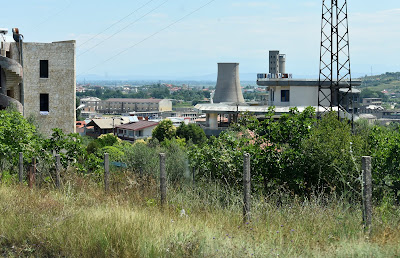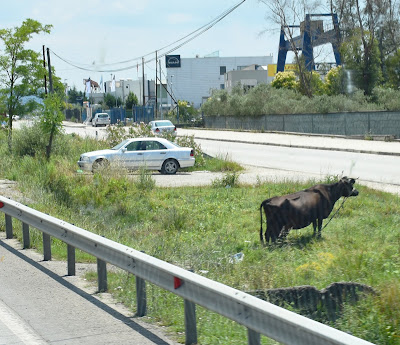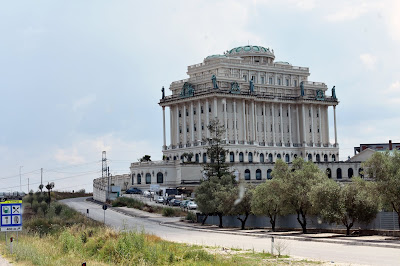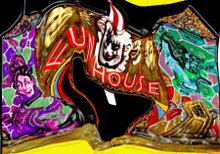Albania Day Two
So the next morning we would drive around on the bus a lot and get a tour of Albanian highways with our guide.
It is an sbsolutely gorgeous country and because of the communist dictatorship it has not been over-developped and despoiled. This makes me think about the price of progress and wonder about what really is forward thinking, especially when you realize that such a large percent of the flora and fauna of Europe is still found here and no longer found in the developed countries to Albania's west.
As in Greece there are beautiful mountains.
It seems like life there is less complex. There are lots of animal herds on the sides of the road and you see people with donkey carts moving food from one place to another (alas ,I did not manage to get a good shot of one of the donkey carts.)
We followed this river quite a ways. It was crystal clear and a beautiful aquamarine color.
There were all kinds of enterprising vendors along the side of the road. Everything was lined up perfectly and in a highly attractive fashion.
I don't know what this means in Albanian (I think it might be a family name), but it is a curious name for a business. Our guide said people were very proud of their cars - weird manhood thing? Anyway, there were car washes everwhere.
More bovine entertainment.
This dog had his territory staked out. He seems fairly old, so I guess I shouldn't worry about him.
These are just random pictures from the bus. The guide told us about the major industries of Albania and all the minerals: coal, bauxite, petroleum, natural gas, copper, iron ore, chromite, and nickel, etc.
... but we mostly saw agriculture. The major crops of Albania are tobacco, figs, olives, wheat, corn, potatoes, sugar beets, grapes, etc. One big area of interest is medicinal and aromatic plants (again related to the great biodiversity in Albania). 18.9% of the Albanian GDP comes from agriculture.
Once again it was women we saw working the fields. (Which may explain why the taverns are so full of men. Although which is the cause and which the effect?)
Here are some sheep by the side of the road.
I love this woman all dressed in black! It was a really hot day, too! Seems like she would wear white, although she does look really "put together" in her matching hat!
Here are more random shots of the mountains...
and another shepherd with his flock (just above the road this time).
and another one.
Petroleum is a major product here and we did see operating oil wells.
Wikipedia says there are no nuclear power plants in Albania, even though there were plans to build them. I'm not sure what this picture means. I found a 2012 article talking about postponing the building of a nuclear plant in the Shkoder area until they could look at environmental impact. Maybe this means they decided it would be okay.
To me there is a certain resemblance of rural Albania to rural Mexico, perhaps it is the warm climate, the bright colors, the donkeys, etc. Perhaps I am not looking carefully enough.
There are lots of desserted, crumbling buildings.
Lots of cows too!
I love this shot of a man sitting on the steps in a town.
The juxtaposition of the parasol and east bloc buildings makes this an interesting shot.
Our guide said something to us about the color of the buildings, but he was a little bit snarky at times and sometimes I wasn't sure if I caught his irony. Anyway, if I understand it correctly, after the communist regime changed (when grey and neutral colors were emphasized for buildings), people in Tirana (the largest city in Albania) began painting the buildings in bright colors and this was a phenomenon for which this city became known. (See this Tourist link for more pictures and info.)
Even though a large city, it still felt like a small town at times.
There is something intimate and village-like about these too guys on the street.
Mosques were abundant.
Our guide (who was clearly a guide during the communist era as well as now) made comments about all the money from foreign lands being brought in to build religious buildings.
Mosques in oarticular were in evidence both in the countryside and in the towns.(They are easy to spot with their tall minarets.)
This was an interesting palatial construction.
We headed north of Tirana toward Fushë-Krujë and of course the cows had less room as we got into the city. This one seems to be tethered to the green strip between the road and the highway.
There are some impressive buildings in Albania.
Albania also prides itself on being the ethnic homeland of Anjezë Gonxhe Bojaxhiu.
You probably know her better as Mother Teresa. She was actually born in Skopje, Macedonia, but to a family of Albanian heritage.
I'm not sure what this building was, but it was amusing.
Fushë-Krujë was a unique city to visit, because George Bush visited it in 2007. He was the first (and only? sitting) U.S. president to visit Albania and he is quite beloved there. He visited this bakery, which has since been named after him (as has been a major Street in Fushë-Krujë)
Here is another of the many bomb shelters. that we passed on our way to Krujë from Fushë-Krujë
The bazaar in Krujë was clean and pretty modern, with those typical winding pathways and Albanian tourist gifts. We stopped here for lunch.
This was a great place to get Albania t-shirts.
We ate a leisurely meal at the Panorama restaurant on top of the hill/mountain. It was really a top-notch culinary establishment (and the prices were quite reasonable.)
Here is our waiter taking our order. Service was a bit slow, but the food was well worth the wait.
Here are some pictures of the actual food we got. I don't know what this was, but I love the presentation!

This salad was really delicious!
We met back at the bus as soon as we could get away from the restaurant,
but, we didn't get off immediately. We had to wait for a couple of pedestrians that wanted to cross the street in front of us.
We continued on our way and I took pictures of people and places we passed by. (Notice the huge fortress at the top of the mountain.)

This fortress may be Rozafa castle, an Illyrian stronghold captured by the Romans in 167 BC/E, I'm not sure.
As we hit the northwestern part of Albania, it was time to say goodbye to our guide.
He tipped his hat to us as we left him on the corner and headed on our way to Montenegro.
We said one last goodbye to the socialist sculptures...
... to the roadside fruits sold out of people's car trunks....

....to the people walking animals beside the highway....
to the (mostly) women working in the fields...
... and of course to the thousands of bomb shelters left over from the cold war and post-soviet split!




























































No comments:
Post a Comment